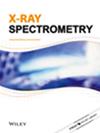Applicability of total reflection x‐ray fluorescence for heavy metal analysis in Lake Baikal sponges
IF 1.5
4区 物理与天体物理
Q3 SPECTROSCOPY
引用次数: 0
Abstract
Oxidative stress of Lake Baikal organisms can be caused by pollution of nearshore with anionic surfactants or heavy metals. Some specific heavy metals are essential for aquatic organisms. At present, there are no data concerning heavy metal content caused by anthropogenic pollution or chemotaxonomic features of Baikal sponges. Here, we consider the applicability of total reflection x‐ray fluorescence (TXRF) to analyze heavy metals in Lubomirskia baikalensis to fill this gap. It was shown that TXRF method can be successfully applied to the fast and reliable quantification of Cu, Zn, Fe, and Mn in this object. Evaluation of different sample treatment procedures showed that the acid digestion by HNO3/H2O2 mixture is an optimal procedure for the preparation of sponges compared with suspension preparation. It helps to improve sensitivity, eliminate the effects of particle size and specimen heterogeneity. The total uncertainty of the TXRF results associated with the sample preparation, taking, depositing, and measuring of the specimen was 6%–18% for Mn, 3%–5% for Cu, 5%–12% for Fe, and 4%–5% for Zn. To validate the developed method, the TXRF results were compared with the data obtained by wavelength dispersive x‐ray fluorescence spectrometry. A good agreement of results was achieved. TXRF data show the dominance of essential heavy metals in L. baikalensis (n = 14) among other heavy metals. Correlations between Cu/Zn contents (R2 = 0.515) as well as between Fe/Mn contents (R2 = 0.972) can be explained by the contribution of them to L. baikalensis antioxidant system.全反射x射线荧光在贝加尔湖海绵重金属分析中的适用性
贝加尔湖生物的氧化应激可由阴离子表面活性剂或重金属污染近岸引起。一些特定的重金属对水生生物是必不可少的。目前,还没有关于人为污染引起的重金属含量或贝加尔海绵化学组学特征的数据。在这里,我们考虑了全反射x射线荧光(TXRF)分析白俄罗斯鲁博米尔斯基中重金属的适用性,以填补这一空白。结果表明,TXRF方法可以成功地用于该对象中Cu、Zn、Fe和Mn的快速可靠的定量。对不同样品处理程序的评估表明,与悬浮液制备相比,HNO3/H2O2混合物的酸消化是制备海绵的最佳程序。它有助于提高灵敏度,消除颗粒大小和试样不均匀性的影响。与样品制备、采集、沉积和测量相关的TXRF结果的总不确定度,Mn为6%–18%,Cu为3%–5%,Fe为5%–12%,Zn为4%–5%。为了验证所开发的方法,将TXRF结果与波长色散x射线荧光光谱法获得的数据进行了比较。取得了良好的一致结果。TXRF数据显示,在甘蓝中,必需重金属(n = 14) 以及其他重金属。Cu/Zn含量之间的相关性(R2 = 0.515)以及Fe/Mn含量之间(R2 = 0.972)可以用它们对甘蓝抗氧化系统的贡献来解释。
本文章由计算机程序翻译,如有差异,请以英文原文为准。
求助全文
约1分钟内获得全文
求助全文
来源期刊

X-Ray Spectrometry
物理-光谱学
CiteScore
3.10
自引率
8.30%
发文量
38
审稿时长
6-12 weeks
期刊介绍:
X-Ray Spectrometry is devoted to the rapid publication of papers dealing with the theory and application of x-ray spectrometry using electron, x-ray photon, proton, γ and γ-x sources.
Covering advances in techniques, methods and equipment, this established journal provides the ideal platform for the discussion of more sophisticated X-ray analytical methods.
Both wavelength and energy dispersion systems are covered together with a range of data handling methods, from the most simple to very sophisticated software programs. Papers dealing with the application of x-ray spectrometric methods for structural analysis are also featured as well as applications papers covering a wide range of areas such as environmental analysis and monitoring, art and archaelogical studies, mineralogy, forensics, geology, surface science and materials analysis, biomedical and pharmaceutical applications.
 求助内容:
求助内容: 应助结果提醒方式:
应助结果提醒方式:


